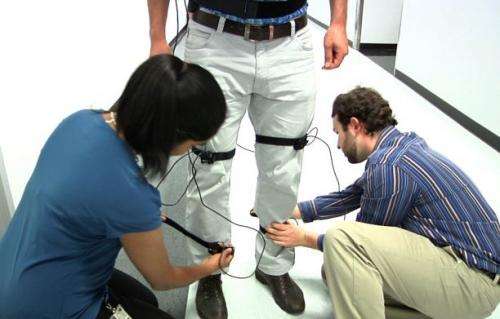Can a sensor prevent diabetic foot amputation?

In the global effort to prevent diabetic foot amputations, one of the most effective tools is a fairly simple, comfortable boot.
The boot, called a removable cast walker, is prescribed by physicians to prevent – or heal – foot ulcers in people with diabetes.
Ulcers are caused when a person with diabetes loses sensation in the foot and cannot feel a blister forming. Left unchecked, an ulcer can lead to amputation and even death.
While the removable cast walker is highly effective in promoting healing by reducing harmful pressure on the bottom of the foot, it won't work if a patient doesn't wear it.
Researchers with the University of Arizona department of surgery are teaming up with a small business partner to design an innovative technology aimed at boosting patient adherence to prescribed footwear.
Funded through a $400,000 National Institutes of Health Small Business Innovation Research grant, the partners have developed a sensor that will alert study participants when they neglect to wear the prescribed footwear.
"People sometimes don't realize how important it is to wear it," said Bijan Najafi, associate professor of surgery in the UA department of surgery Southern Arizona Limb Salvage Alliance, or SALSA, and director of Interdisciplinary Consortium on Advanced Motion Performance.
"Maybe they think they are walking just a few steps around the home, and they don't need it," he continued.
Researchers are partnering with BioSensics, a company in Cambridge, Mass., to design the interactive sensor technology used in the year-long first phase of the study.
The team created a prototype – a small black box worn in the removable cast walker. The wireless sensor measures the cast activity. Study participants will wear a "smart" textiles shirt, which uses sensors to measure a person's activity. Data from the shirt and the sensor will evaluate whether the patient is wearing the footwear as prescribed.
"If you forget to wear the removable cast walker, the sensor alerts a watch you are wearing," said Najafi, a biomedical engineer. "The watch will buzz to let the participant know they are not wearing the boot."
The ultimate goal is to create a simple, inexpensive device that people with diabetes around the world can use to increase adherence to prescribed footwear, whether it be special shoes or the removable cast walker, which is known as the gold standard in diabetic wound healing.
Najafi said some patients may not realize how critical it is that they wear the removable cast walker, which often is prescribed for 12 weeks or more.
Diabetes is a growing concern in the U.S. and around the globe. While 8.3 percent of the U.S. population has diabetes, that number is expected to rise. According to the Centers for Disease Control and Prevention, as many as one in three adults in the U.S. could have diabetes by 2050.
Every 20 seconds in the world, a limb is lost to diabetes. "It's very problematic but very preventable," Najafi added.
Fifteen patients from the UA's SALSA Clinic will wear the sensor and receive an alarm if they are not wearing the removable cast walker. Another 15 patients will wear the sensor and receive an informational DVD to watch on the importance of adhering to the prescribed footwear. Researchers will determine which method has a greater impact on adherence.
"This simple solution can prevent foot amputation," Najafi said of the technology.
Dr. David G. Armstrong, professor of surgery and SALSA director, said the technology helps to combat the effects of peripheral neuropathy that occurs in people with diabetes, resulting in the loss of sensation in the foot.
"People with diabetes, over time, lose the gift of pain," Armstrong noted. "Work that we did more than a decade ago found that 85 percent of activity was taken inside the home – but only 15 percent of people with diabetes wore their shoes inside their home. Amazingly, even if they had wounds, this did not change very much. We'd like to improve that."
Armstrong and Najafi believe the technology could have applications beyond foot ulcers.
"We imagine integrated devices that can help assist patients, nurses and doctors fit and wear anything that is put on or in their body," Armstrong said. "This is truly the future of mobile health."














